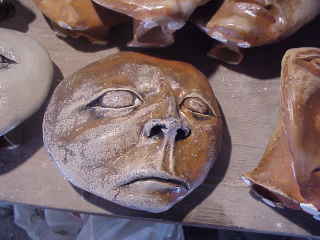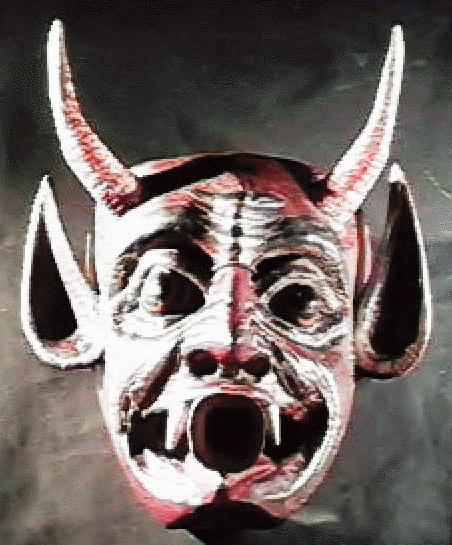By Hilary Kerrod*

Gamitadera-mask after firing.
First version, March 19, 2003. Last version, April 12, 2003.
Construction procedure:
- Step 1.
Two hemispheres (bowls) of clay are made, one deeper than the other. (I currently shape these over the handle of a knife, a small mould is also good.)
- Step 2.
Score the smaller 'bowl.
- Step 3.
...and attach it to the top of the taller one, leaving an airspace between them.
- Step 4.
Cut the top of the smaller 'bowl' off about halfway up (like opening a boiled egg). There should be a wall of clay around the slightly mounded top of the lower 'bowl'.
- Step 5.
Use a 'whistle stick' to make a slit in the side.
- Step 6.
Use two drills to make the interior holes. The larger one is used to make the lower hole. Make it in the middle of the 'mound'.
- Step 7.
Shows the larger of the interior holes.
- Step 8.
Use a small scooped blade to neaten the hole on the inside. I find this step to be very important. Try not to enlarge the hole, you may need to reshape it carefully with the drill. Remove any crumbs of clay. If you mess it up totally, seal with a small ball of softish clay, smooth out and try again. (from one who has done it.)
- Step 9.
Using the 'whistle stick' to protect the first hole, replace the cap of clay UPSIDE DOWN. It will be slightly dished now.
- Step 10.
Shows the dished top of the cap. Neaten the side hole and withdraw the 'whistle stick'.
- Step 11.
Line up the second, slightly smaller drill THROUGH the first hole. This way the two holes will be perfectly aligned.
- Step 12.
Shows the drill emerging from the hole. Pull it through.
- Step 13.
Neaten the second (top) hole. Put the whistle stick in to keep the space between the two holes.
- Step 14.
Press the Gamitadera against your palm to test it. If it works, seal the bottom with a pancake of clay. If it doesn't work?... Are the holes aligned? Is the lower (inner) hole slightly larger than the outer one? only slightly. Is there clear space between the two holes? Is the inner surface clear and the edge of the hole sharp? What about the outer one? Is the side hole big enough? BE PATIENT AND PERSISTENT.
- Step 15.
Add resonating chambers. Here is where I got over excited and added a complex triple chamber with curving triangular sections. Sorry. But it sounds Very Cool. A simple open tube would have done.
The gamitadera can be attched to a life sized masks. These are a front and a rear view of an unfired face mask.
I have a small exhibit at Easter in the local Waiheke Community Art Gallery, and hope to have between 12 and 20 finished. I plan to soda-fire them, an eighteen hour firing. The photo will be posted when I have them finished and fired in my big soda kiln.
This is the final report:
Only one mask seems to have 'lost' its voice in the inferno. I had a number break in the preliminary firings, but the final one was pretty successful- as well as exciting. At one point I had 2 feet of flame coming out of my chimney! It takes me a day to stack the kiln and
build the 'wicket' to close it in, another long day firing, then an anxious day
when the kild is far too hot to touch. I think it went up to about 1100'
The first photo shows the masks before they went in, there is one of the
kiln before I unpacked it, and closer-ups of the
masks. The light brown mask in the first photo emerged almost black. The browns
and reds are flame and soda effects on white clay, very suitable for the
Underworld. (My exhibition is 'Voices from the Underworld') Most are shiny,
some are quite dry, but they look lovely to me right now.
These are the last photos of the firing:
This text of my statement of the exhibition:
'VOICES FROM THE UNDERWORLD. This body of work is based on the ancient Mexican aerophones known as 'gamitadera'. I first came across these on a wonderfully informative website run by Roberto Velasquez Cabrera. Virtual Research Institute Tlapitzcalzin (http://www.geocities.com/rvelaz.geo). Gamitadera work on a completely different principle from the whistles I had been making before. It took me some weeks to begin to get sound from them, and I am still experimenting with the variables of construction. The sounds these aerophones make are also different from the whistles I usually make. Gamitadera moan, cry and even growl rather than going 'tweetle tweet'. As 'gamo' means 'deer' (and 'gamito' means little deer) it is probable that they were used as deer callers, as well as to imitate other animal and human sounds. I believe they were made to resemble the animals whose sounds they imitated. It is highly likely that they had religious and cultural uses about which I can only speculate. Their sounds seem closer to conch-shell or kouaua than anything else. I have attached these aerophones to masks in order to convey the unearthly quality of their sounds. This also allows the person blowing them to be masked, and so adds an element of ceremony or theatre to their use. The larger works are designed to hang on the wall, but also to be free-standing on a table or plinth. I have soda fired them, a process similar to salt firing, and the finished results reflect their placing in my kiln as well as their pre-firing treatment. The smaller works are shell whistles, using the same principle."
These are the photos of the exhibition:
* Hilary Kerrod is a fine ceramist from New Zeland that found a good procedure to make the olmec whistle considering the information provided in the paper "Virtual Analysis of Gamitadera" and self experimentation. The instructions and photos of each main step for the construction procedure were provided by Hilary. The real ancient gamitadera is in exhibition in the Museum of Anthropology at Xalapa, Veracruz, Mexico. Initially, it was analized and published in a paper by Susan Rawcliffe.
'Voices from the Underworld' is a very good title for the exhibition, because many of those complex noisy sounds seem from the underworld. The masks were and are used in many dances in Mexico. The mexican family of the gamitadera has many members with many names, like "spring aerophones", "double diaphragm aerophones", "chamberduct flutes", "mouth whistles", "wind whistles", "mexican noise generators", "whistles of the death", etc., but their ancient names and uses are unknown. This is a "mouth aerophone-mask of the devil" or "aerophone of the devil" and it can be used to dance and roar like this devil:

Studies on mexican aerophones


